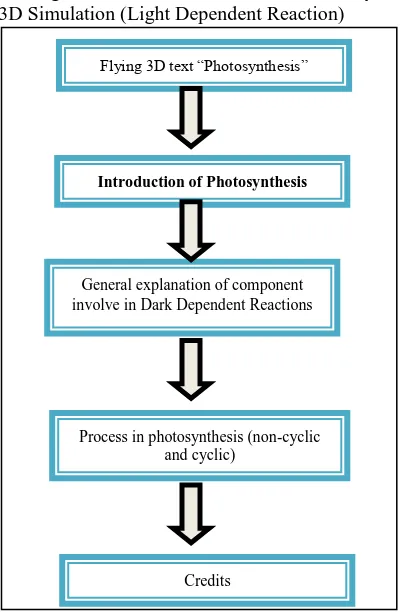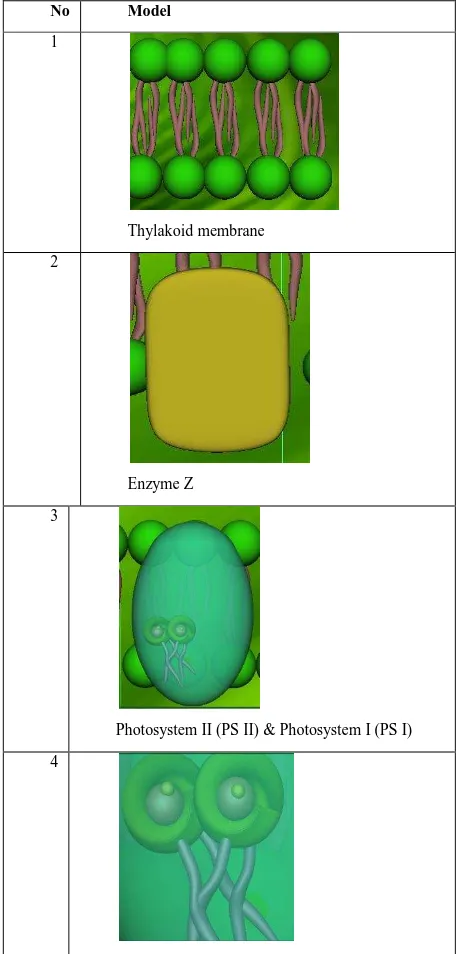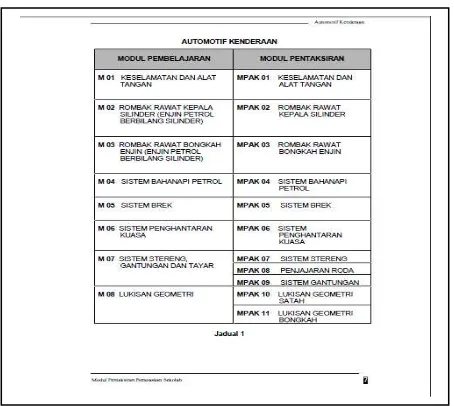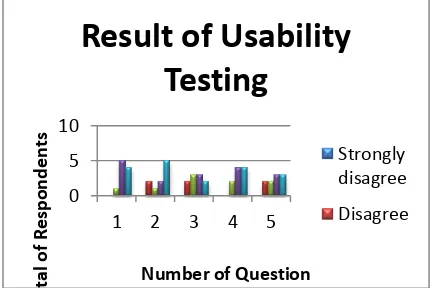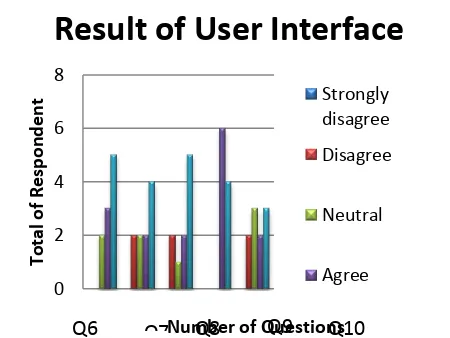The Study on 3D Simulation Usage in Teaching and Learning Process
Sarni Suhaila Rahim1, Wan Sazli Nasaruddin Saifudin2, Siti Syahidah Alias3, Mohd Ikbaruddin Mat Rani4 Faculty of Information and Communication Technology (FTMK)
Universiti Teknikal Malaysia Melaka (UTeM) {1sarni,2wansazli} @utem.edu.my
Abstract – Simulation can be a powerful tool if understood and used properly. Simulation can be an extremely useful instructional aid. This paper will present the study on 3D simulation usage in teaching and learning process. The paper will focus on two projects developed in 3D simulation domain which are Photosynthesis 3D Simulation (Light Dependent Reaction) and also 3D Simulation of 2-Stroke and 4-Stroke Engine. The simulation can help in introducing components that are purely virtual, concepts that cannot be easily realized, but still useful for learning. There are some difficulties to the students where they have to face during learning process, especially the nature process that hard to
see with naked eyes.
Various means used by teachers to deliver lessons to
students but how effective the teaching method used is depends on the lecturer or teacher. Textbooks, references book, slide presentation and fact in graphics are some of the current teaching methods that are still used. This method is not entirely effective, but for students who have a weak imagination is pathetic. Therefore, 3D simulation is developed to overcome this difficulty.
Keywords: Simulation, 3D visualization, teaching and learning
I. INTRODUCTION
Simulation gives lot of benefit. The list below is the benefit of simulation [4]:
i. Low Barrier to Entry
Simulation enables individuals using a personal computer to develop very interesting robots or robot swarms with the primary limiting factors being time and imagination. At the same time, it constrains them in ways similar to physical robots so they can focus efforts in something that can be realized.
ii. Prototyping
Physical models for a robot and the simulation services that use them can be developed concurrently by many individuals, and just like many software
development communities, create a platform which many can use and modify without worrying about breaking environment. The programmer can also introduce components that are purely virtual, concepts that cannot be easily realized, but still useful for learning.
iv. Learning System
Another interesting aspect of simulation is that it can be used while the robot is running, as a predictive tool or supervised learning module. For quite some time, developers have used simulation running concurrently with an active robot to try things out in the simulation world that is updated real-time with sensory data. Then the simulation can tell them, probabilistically, if something is a good idea.
II. PROJECT DEVELOPMENT
There are two projects being involved in this study which are Photosynthesis 3D Simulation (Light Dependent Reaction) and also 3D Simulation of 2-Stroke and 4-2-Stroke Engine. Both project use 3D simulation for better visualization.
A. Photosynthesis 3D Simulation (Light Dependent Reaction)
additional teaching aids to help them for better understanding of the topic.
In Biology matriculation syllabus, this topic is quite complex because it covers till depth. The process of photosynthesis is a complex process thus it is essential to give better visualization to life students. The components involved in photosynthesis were modeled in 3D environment.
According to Soon Ching and Shee Leong (2006) with the reference book “EXCEL in Biology for
Matriculation semester 1” mentioned that photosynthesis
is the formation of organic nutrients in an organism using inorganic raw material and energy from sunlight.[5] The 3D simulation explains each of the stages in plant photosynthesis. Photosynthesis generally consists of two main processes. The first process is called the Light Dependent Process (Light Reactions) and the second stage is called the Light Independent Process (Dark Reactions). The first process is the Light Dependent Process (Light Reactions), requires the direct energy of light to make energy carrier molecules that are used in the second process. The Light Independent Process (Dark Reactions) occurs when the products of the Light Reaction are used to form C-C covalent bonds of carbohydrates. The Dark Reactions can usually occur in the dark, if the energy carriers from the light process are present. However, this project will focus Light Dependent Process (Light Reactions) which consists of non-cyclic photophosphorylation and cyclic photophosphorylation.
The current methods of teaching this particular area are through slide presentation, OHP transparency, text book and other material. This can be the problem to some of the students especially to visualize or imagine the whole process. So, basically the education field will used this product as their teaching aid in matriculation or maybe tuition center. Based on observations and research done for examples from YouTube, there are lots of simulations of this topic but it covers too general and not really suitable for students.
The current teaching methods for example slide presentations, transparencies or text books are not really efficient for student to have better understanding about the process. Not all students have the ability to imagine the things that they cannot see. One of the methods to give better visualization about the process is through animation. There are a lot of video of animation that describe about the photosynthesis process, unfortunately the video is not suitable for student who taking this topic. It is because it shows general concept of photosynthesis process. It is hope that through this simulation it can help students to easy their learning process about the topic.
This project was developed to simplify the learning process. There are two groups of target user for this project. Primary user is for Biology students and Biology lecturers in matriculation program who are
secondary user is for people who may have general knowledge about photosynthesis process and eager to know more about the process. The simulation covers explanation of each stage in plant photosynthesis specifically for Light Dependent Process which consists of non-cyclic photophosphorylation and cyclic photophosphorylation.
The main platform of this project uses Autodesk Maya 2010 to model the components involved in the photosynthesis process and later was animate using the combination of 2D animation, sound and effect from Adobe After Effect software.
The significance of this project is to help Biology students in matriculation to have better understanding about the whole process of photosynthesis. Moreover, the lecturer also can use this product as their teaching aids to make the learning process easier, fun and efficient. Besides, people who are eager to have additional knowledge about the process also can use this product.
From the project, it will assists Biology students of matriculation to gain better understanding, have better visualization and make the learning process become interesting through this simulation. Besides, they are not only acquiring knowledge but also gain exposure to the current 3D technology, which they may not realize. It was felt that the need of additional learning tool such as visual simulation is required in order to able more understanding especially when involving complex process.
Figure 1 shows the flowchart of Photosynthesis 3D Simulation (Light Dependent Reaction)
Flying 3D text “Photosynthesis”
Introduction of Photosynthesis
General explanation of component involve in Dark Dependent Reactions
In the project requirement, the overall analysis of the system to be developed is explained.
i. Frame Rate
Frame rate is the first aspect of animation. This simulation using 24 fps (frame per second). The length of this 3D simulation is 3 minutes that equal to 180 seconds.
Total frames = 24fps × 180secs = 4320 frames
ii. Animation Types
Keyframe animation is implement during animate the scene and it is the standard animation method. In this method, keys are set for an object's extreme positions and let the computer fill in-between motion. A key is an anchor point for a particular attribute at a designated time. When the animation reaches that specified time, the object's attribute will be at the value set. As the key set, specify the time at which those changes in the attributes value take place. Animation is the main element that can make any product more interesting, so in process adding animation, it needs to be careful because too many animations will distract the focus of the students to get all the information.
iii. Text
Text also will be used in this simulation to give explanation and description. Text also to support the graphics and also used for giving general information.
iv. Audio
I. OTHER THAN GRAPHIC, ANIMATION AND TEXT; AUDIO PLAYS AN IMPORTANT ROLE IN LEARNING PROCESS. THEREFORE, VOICE OVER TECHNIQUE WILL BE USED IN THIS PROJECT IN ORDER TO GIVE BETTER EXPLANATION AND MAKE THE LEARNING PROCESS BECOME MORE EXCITING.BEFORE RECORDING THE VOICE, THE SCRIPT MUST BE PREPARED.THE PHRASING IN TEXT IS LEAN, MEAN AND EASY TO PRONOUNCE.
v. 2D Animation
2D animation also embedded in this simulation to animate the effect like sun light and chemistry equation that are easy to animate in flash.
After modeling the components of Light Dependent Reaction process, props and also environment, the animate activities is begin by setting commons such as frame per second. Table 1 shows the production process of animation.
TABLE 1. ANIMATION PRODUCTION PROCESS
No Model
1
Thylakoid membrane
2
Enzyme Z
3
Photosystem II (PS II) & Photosystem I (PS I)
4
5
Plastoquinone (Pq)
6
Cytochrome B6 –f complex
7
Plastocyanin (Pc)
8
Electron acceptor FeS
9
10
NADP+ Reductase
11
ATP Synthetase
B. 3D Simulation of 2-Stroke & 4-Stroke Engine
This project is a three dimensional (3D) animation which is intended for the user that involve in mechanical or automotive subjects but also compatible for all types of user. The project will shows the user the differences in performance, components and the cycle between 2-stroke and 4-stroke engine.
Currently, students and teachers are using paper-based materials such as books and hand-outs as their references or manual in order to complete the compression test. Compression test involves process to differentiate between 2-stroke and 4-stroke engine and identifying the components that involves in these two engine cycle.
and also teachers to overcome all the problems that stated above, especially to give better understanding on how to differentiate between 2-stroke and 4-stroke engines and identifying components that involved in those machine cycles to the students. At the same time, this also can attract students on how they are learning.
Figure 2 shows the module that is used currently at all Sekolah Menengah Teknik in Malaysia.
Figure 2 : Vehicle Automotive Module
Figure 3 below shows the sample of the content in the module that has been used currently in Sekolah Menengah Teknik. The content which mostly consists of
text does not attract student’s interest in learning the
subject. In the mean time, student also seems to be hard to understand just by reading this kind of contents.
Figure 3 : Module Content
The target audiences of this project are students from Sekolah Menengah Teknik who are taking Vehicle Automotive Subject. Besides, user from age 15 and above who are interested and involved direct or indirectly in automotive arena can use this project.
The content of the project is 3D animation about processes of differentiating between 2-stroke and 4-stroke engine, performance and identifying components involved in those engine cycles. The animation will be delivered in a video content which will be saved in Compact Disc (CD) because in school, there are limitations of device to run the program. So, CD is the most flexible and easy deliverable medium because it can be run on many devices such as PC and VCD player.
The final product of this project will provide useful information to the users especially the students from Sekolah Menengah Teknik who are taking Vehicle Automotive Subject. The successful project will help the user to have clearer understanding of their modules besides attracting them to learn rather than the existing system which using books and hardcopy that is quite boring and uninteresting nowadays. This also will benefit the teachers which is they can explain to student by only using the simulation. As for the educational purpose, this application also can be as an additional tool in learning. The project is highly recommended for Kementerian Pelajaran to distribute the simulation to all vocational schools in Malaysia.
Based on researches that have been done, there are existing systems that have been developed before by other student and also can be found in the internet. The existing systems are using animations which some of them not quite interesting and some of them also not helping the student. Most of the animation are only focusing on how the engine actually works but not included the components in the engines. So it is hard for the student to learn according to their syllabus.
Navigation flow is important for any projects to show the flow of the product or system.
Figure 4 : Navigation Flow
III.THERE ARE TWO MAIN CHARACTERS THAT BEEN
USED IN THIS PROJECT WHICH ARE 2-STROKE ENGINE
AND 4-STROKE ENGINE.TABLE 2 SHOWS THE CHARACTER THAT BEEN USED IN THE ANIMATION
PROJECT.
TABLE 2. CHARACTER PROFILE
Table 3 below shows the 2-stroke engine in different views including front, side, back and perspective view.
Table 4 below shows the 4-stroke engine in different views including front, side, back and perspective view.
TABLE 4. FOUR STROKE ENGINE IN DIFFERENT VIEWS
IV.PROJECTSTRENGTHS
Good planning is crucial to ensure the development of product is always meets the objective and fulfill the user requirements. The strength proven the 3D simulation is the best way for current needs and gives impact in teaching and learning process. Amongst the strengths of the projects are:
i. Based on the user testing done, overall every respondent satisfied with this product because it is simple to use and easily understand the about the topic.
ii. The navigation and interface is clear, the explanation is quite good and can be enhanced with addition detail information.
iii. Respondents prefer simulation base as a medium for teaching aid rather than video based because simulation is more attractive and makes them become more understand about the topic.
iv. The 3D simulation is attractive due to the pleasant interface and the usage of colour is suitable.
v. This product can be attractive to gain students attention and interest in learning the topic rather than only using the old teaching method which is books.
vi. Using 3D animation as learning contents provides a better way to illustrate. Good illustration will give a good understanding to the audience.
vii. This product can conduct a safe environment for learning especially for beginners.
V. TESTING AND RESULT
For both 3D simulations, user testing was conducted with objectives to measure the user acceptances level and effectiveness of the 3D simulation. Five questions were asked on usability aspect which are:
Result were gathered and analyzed. Figure 4 below show the results of usability testing.
Figure 4 : Usability Testing Results 0
1 It is simple to use this simulation.
2 I feel comfortable using this
VI. TABLE 6 BELOW SHOW THE QUESTIONS OF THE USABILITY TESTING FOR THE 2-STROKE AND 4-STROKE 3D SIMULATION WHILE FIGURE 5 SHOW THE ANALYZED RESULTS.
TABLE 6. USABILITY TESTING QUESTIONS
II. FROM BOTH USABILITY TESTING CONDUCTED, MOST OF THE RESULT SHOW A POSITIVE RESPONDS. THIS GENERALLY SHOW THAT THE USED OF 3D SIMULATION IN DELIVERING INFORMATION FOR BETTER LEARNING EXPERIENCE ARE WIDELY ACCEPTED AND HELPFUL.
Figure 5 : Usability Testing Results
III. CONCLUSIONS
In conclusion, the projects have been successfully developed to achieve certain objectives in supporting school learning. Generally, the projects have been developed accordingly and meet the objectives. This project can contribute in education field. Kementerian Pengajian Tinggi and Kementerian Pelajaran Malaysia may distribute the application to all matriculation and vocational schools in Malaysia as teaching aids or tool. It is hope that it can helps students to have better understanding about certain topics. In addition, through this application it makes the students familiar with computer technology that is very powerful and sophisticated. The projects really give big impact in the use of 3D animation for teaching and learning process.
REFERENCES
[1] [1] Siti Syahidah Alias, Sarni Suhaila Rahim, “Photosynthesis Simulation (Light Dependent Reaction)”, PSM Thesis, 2011, Universiti Teknikal Malaysia Melaka.
[3] Ricki G. Ingalls, “Introduction to Simulation” ,
[5] School of Industrial Engineering and Management, 2002 [6]
[4] “Simulation Overview, Benefits of Simulation”, 2010 [Online], Retrieved on Januari 2011from
http://msdn.microsoft.com/en-us/library/bb483076.aspx
[5] Soon Ching and Shee Leong, “EXCEL in Biology for Matriculation Semester 1”, 2006, Pearson Malaysia Sdn. Bhd.
[6] Daniel Brüstle, “Four Stroke Engine Simulation”, 2011 [Online]
Retrieved on February 2011 from
http://www.youtube.com/watch?v=k91yo3unKzY
[7] Video from YouTube, uploaded by HowStuffWorks , “How Two-stroke Engines Work”, 2009 [Online] Retrieved on February 2011 from http://www.youtube.com/watch?v=LuCUmQ9FxMU
[8]Lembaga Peperiksaan, “Automotif Kenderaan”, 2010, Kementerian Pelajaran Malaysia.
[9] Sheung Yee Shing, “Origami V12 Four-Stroke Engine”, 2010
[Online] Retrieved on February 2011 from
http://www.yeesjob.com/v12engine.htm
[10] Su Liang, Luo Xianguang, Bi Yebin, “Research on Key Techniques of Visual Simulation of Automobile Engine Based on Virtual Reality Technology”, 2011, China : Xiangtan University [11] R. Kayne, L. S. Wynn, “What is the Difference Between 2-Stroke
